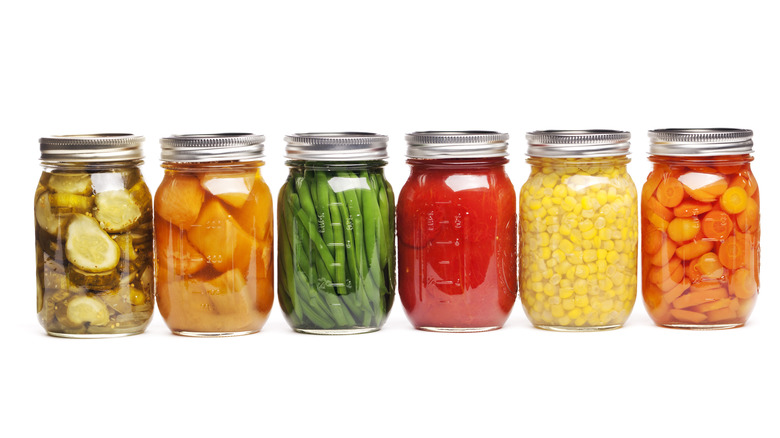Pressure Canning Vs Water Bath Canning: Which Is The Best Method?
More and more, canning is becoming a popular hobby, with home enthusiasts canning various vegetables, fruits, and other food. It's important to know what you're doing when it comes to storing food, and in the realm of canning, there are two primary methods for preservation — water bath canning and pressure canning. Ultimately, it's not a question of which method is better, but it's important to consider which form of canning is best for the situation at hand. If you stick with a hobby for canning long enough, then you'll likely use both methods at some point, as they serve different kinds of food.
According to the USDA, you would use the water bath method for foods high in acid. These foods should have a pH of 4.6 or lower if you're going to water bath can them. Otherwise, if the food has a lower acidity (4.6 PH or higher), you will want to use a pressure canner instead. This is to ensure the safety of your canned goods and lower the risk of botulism. Lower acid foods carry a potential for the deadly toxin. As a result, these foods need to be cooked to a higher temperature than boiling water allows. Low-acid foods should never be canned using boiling water.
How to water bath can
Water bath canning is popular for those looking to try out the hobby without committing from a monetary perspective. Generally, water bath canners are a lot cheaper than pressure canners. You don't need a water bath canner if you have a large pot. The pot should be big enough to allow for two inches of water above the top of the jar. You'll also need a rack to act as a buffer between the jar and the bottom of the pot. Water bath canning is a simple method that uses the extreme heat of boiling water to remove air from the inside of the jar. This creates a vacuum in the jar that will preserve the food.
As already mentioned, water bath canning really only works safely with high-acid foods. So, what is best for water bath canning? In particular, fruits and pickled vegetables seem to go best with this method of canning. You can make a variety of jellies, jams, and preserves. With added vinegar, you can raise the acidity of many low-acid vegetables, making them viable to can with the water bath method. Consider making a relish or a salsa as the perfect side item or condiment for dinner.
How to use a pressure canner
In comparison to water bath canning, pressure canning is more expensive, but it gives you the option to can low-acid food without resulting in pickling. Pressure canners typically run from $100 to several hundred dollars. A pressure canner may resemble a normal kitchen pot with more bells and whistles. In order to pressure can food, you'll heat the pressure canner on the stove top with a few inches of water inside. The pressure canner will create steam, which, similar to water bath canning, will create a vacuum in the jar. However, pressure canners reach a higher temperature than water bath canning.
With a pressure canner, you can preserve a variety of low-acid vegetables, including carrots and asparagus. Besides vegetables, pressure canners are also a great way to can cooked meats and poultry, so feel free to put together that beef stew and save it for later. While pressure canners are typically reserved for low-acid foods, they can also be used to preserve high-acid foods as well. However, the quality may be different than if you were using the water bath method. Ultimately, both methods of canning are viable and should be used appropriately to avoid any mistakes when canning at home.


